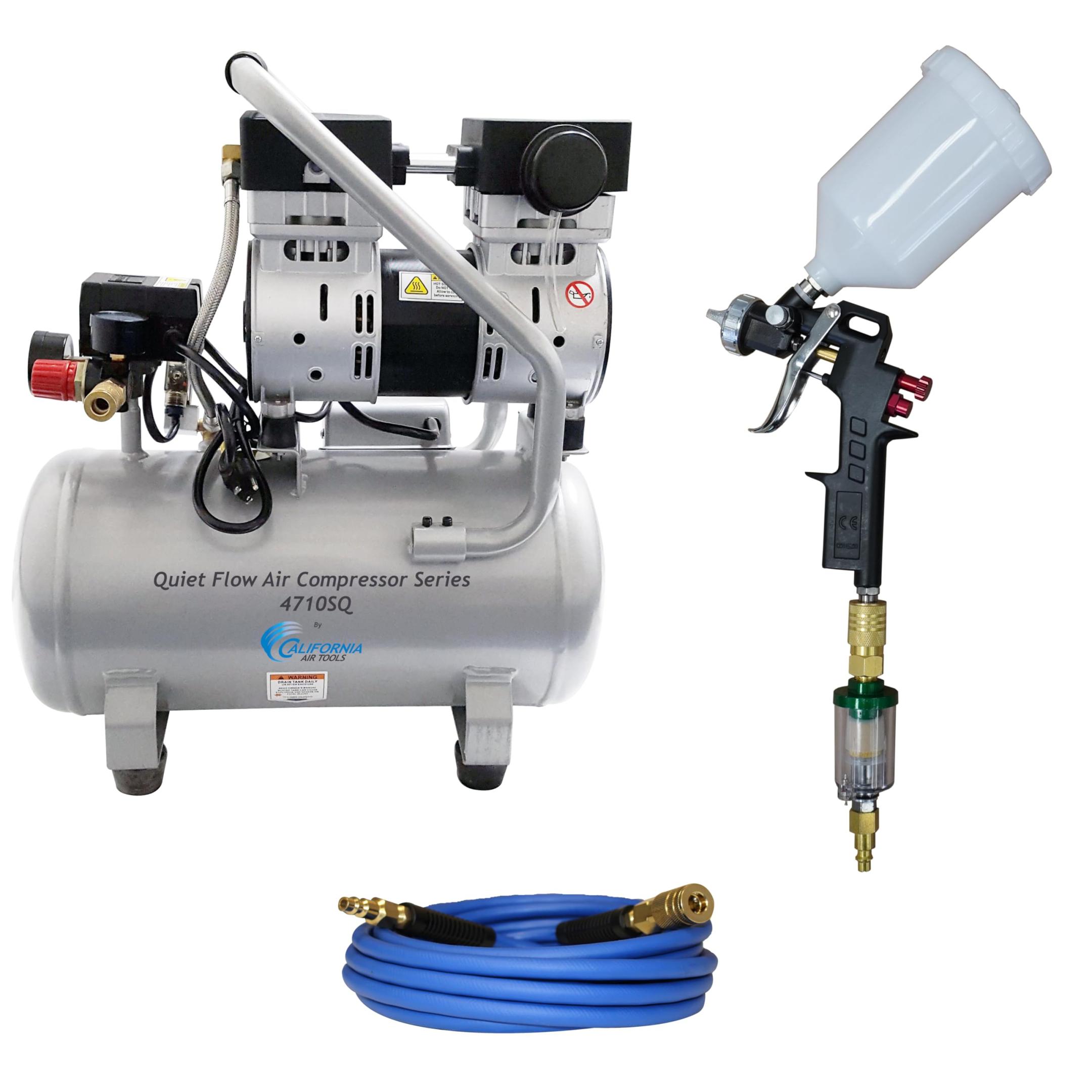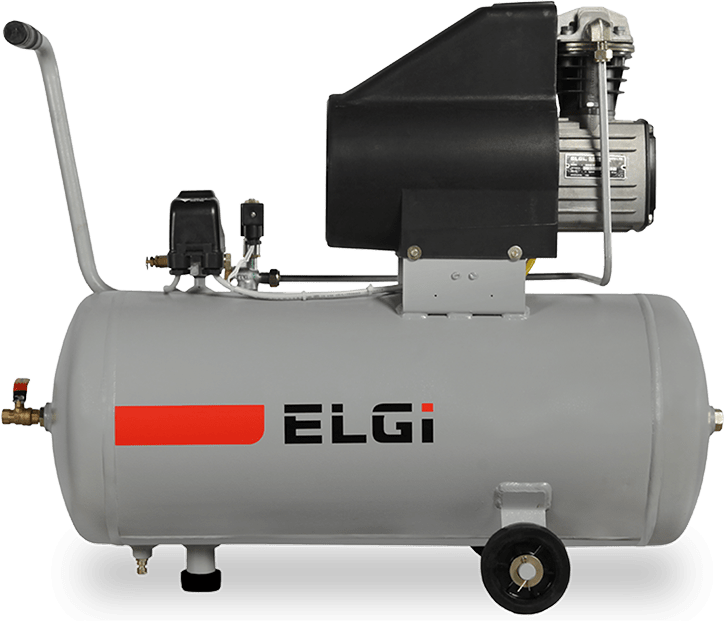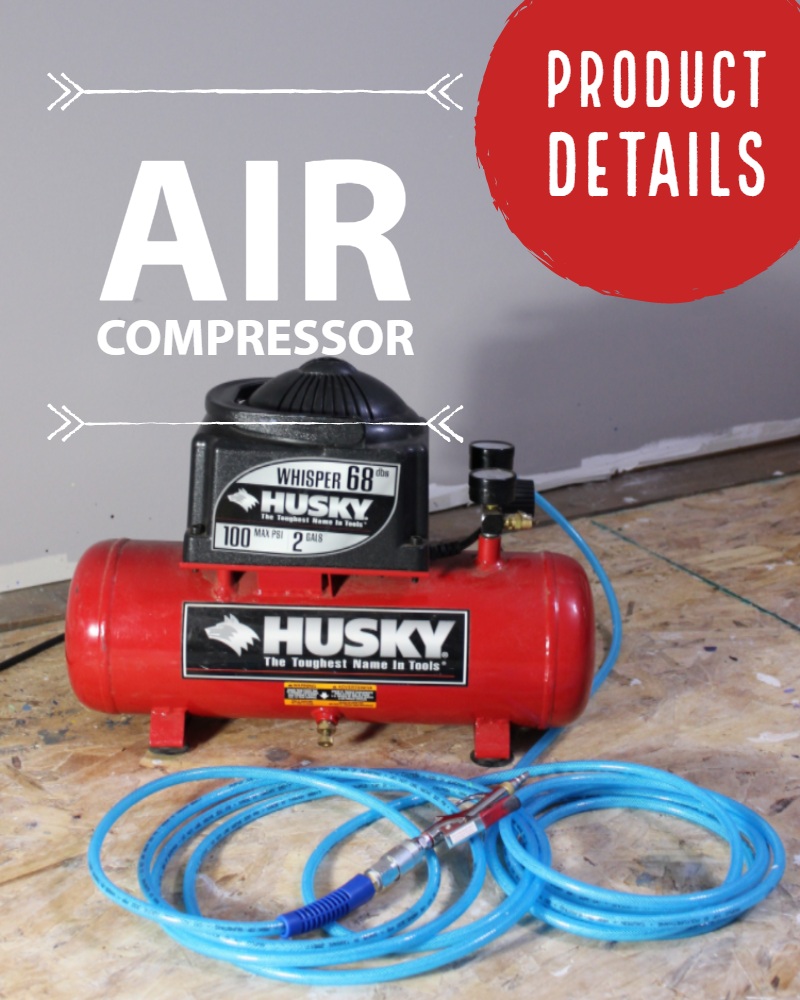
An air compressor for painting is essential for delivering a consistent spray of paint. It ensures a smooth finish and reduces the risk of overspray.
Using an air compressor for painting significantly enhances your project’s efficiency and quality. These compressors provide the necessary pressure and airflow to power spray guns effectively. They come in various sizes and capacities, making it easy to find one that fits your specific needs.
A suitable air compressor can help achieve professional results, whether you’re working on a small DIY project or a large-scale job. Understanding the right specifications, such as PSI and CFM ratings, is crucial for optimal performance. Investing in a reliable air compressor will improve your painting experience and ensure a flawless finish every time.
The Role Of Air Compressors In Painting
Air compressors are vital tools in the painting world. They help artists achieve smooth and even finishes. Whether you are a hobbyist or a professional, understanding their role is crucial.
Essential Tool For Artists
Air compressors provide a consistent flow of air. This helps artists use spray guns effectively. Here are some benefits of air compressors:
- Even paint application
- Reduced brush strokes
- Less paint waste
- Faster drying times
Artists can create intricate designs with ease. The right air compressor can enhance creativity. Different types of air compressors suit various painting techniques.
From Hobbyists To Professionals
Air compressors cater to both hobbyists and professionals. They come in various sizes and capacities. Here is a comparison of popular models:
| Model | PSI | Tank Size | Best For |
|---|---|---|---|
| Portable Compressor | 90 PSI | 1 Gallon | Hobbyists |
| Medium Compressor | 120 PSI | 5 Gallons | DIY Projects |
| Professional Compressor | 150 PSI | 10 Gallons | Large Projects |
Choosing the right model can enhance your painting experience. Consider your needs before making a selection. Air compressors are essential for achieving stunning results.
Types Of Air Compressors For Painting
Choosing the right air compressor is essential for painting projects. Different types offer unique advantages. Understanding these types will help you make an informed decision.
Piston Compressors
Piston compressors are popular for many painting tasks. They use a piston to compress air. This type is known for its durability and power.
- Advantages:
- High pressure output
- Suitable for large projects
- Long lifespan with proper maintenance
- Disadvantages:
- Can be noisy
- Heavier than other types
- Requires more maintenance
Diaphragm Compressors
Diaphragm compressors use a flexible diaphragm to compress air. They are quieter than piston compressors. These compressors are ideal for smaller projects.
- Advantages:
- Low noise level
- Lightweight and portable
- Easy to maintain
- Disadvantages:
- Lower pressure output
- Not suitable for heavy-duty tasks
- Can wear out faster
| Type of Compressor | Pressure Output | Maintenance Level | Noise Level |
|---|---|---|---|
| Piston Compressor | High | Moderate | Loud |
| Diaphragm Compressor | Low | Low | Quiet |
Factors To Consider When Choosing A Compressor
Selecting the right air compressor for painting is crucial. The right choice affects your painting quality and efficiency. Consider several key factors to find the best fit for your needs.
Pressure Requirements
Pressure is vital for achieving a smooth finish. Different tools require different pressure levels:
| Tool | Recommended PSI |
|---|---|
| Airbrush | 15-30 PSI |
| HVLP Spray Gun | 25-30 PSI |
| Conventional Spray Gun | 30-50 PSI |
Check your tools’ specifications. Choose a compressor that meets or exceeds these requirements.
Tank Capacity
Tank capacity affects how long you can paint without interruptions.
- Small Tank: 1-2 gallons. Suitable for touch-ups.
- Medium Tank: 3-6 gallons. Good for small projects.
- Large Tank: 8 gallons or more. Ideal for larger jobs.
A larger tank provides more air supply. This means fewer breaks for refilling.
Portability And Size
Consider where you will use the compressor. Portability matters for mobile projects.
- Lightweight Models: Easy to carry.
- Compact Sizes: Fit in tight spaces.
- Wheeled Compressors: Great for larger setups.
Evaluate your workspace. Choose a model that fits your environment.

Credit: www.elgi.com
Setting Up Your Air Compressor For Painting
Properly setting up your air compressor is crucial for painting. A well-prepared compressor ensures smooth operation and excellent results. Follow these steps to maximize efficiency and safety.
Assembly And Maintenance
Assembling your air compressor requires attention to detail. Follow these steps:
- Unpack all components from the box.
- Read the manufacturer’s manual.
- Attach the air hose to the compressor outlet.
- Connect the spray gun to the other end of the hose.
- Check all connections for tightness.
Regular maintenance keeps your compressor running smoothly. Follow these maintenance tips:
- Drain moisture from the tank after each use.
- Inspect the air filter monthly.
- Change the oil as recommended.
- Check hoses for wear and tear.
Safety Precautions
Safety is vital when using an air compressor. Follow these precautions:
- Wear safety goggles to protect your eyes.
- Use ear protection to avoid noise damage.
- Ensure proper ventilation in your workspace.
- Keep flammable materials away from the compressor.
Before starting the compressor:
- Check for leaks in hoses and connections.
- Ensure the compressor is on a stable surface.
- Set the pressure according to your spray gun’s requirements.
Techniques For Efficient Compressor Use
Using an air compressor for painting requires some techniques. These help achieve smooth results. Proper adjustments and precautions make a big difference.
Pressure Adjustment For Consistency
Adjusting the pressure is vital for even paint application. Too high or low pressure can cause issues. Follow these steps:
- Check the manufacturer’s recommendations for your spray gun.
- Start with a lower pressure setting.
- Test spray on a scrap piece.
- Gradually increase the pressure until you find the sweet spot.
Maintaining consistent pressure ensures:
- Uniform coverage
- Fewer runs and drips
- Less wasted paint
Avoiding Moisture In Paint
Moisture can ruin your paint job. It leads to bubbling and uneven finishes. Keep your paint dry with these tips:
| Technique | Description |
|---|---|
| Use a Moisture Filter | Install a filter on the air compressor line. |
| Drain the Tank Regularly | Release trapped moisture from the compressor tank. |
| Store the Compressor Indoors | Avoid outdoor storage to prevent condensation. |
Implement these methods to keep moisture at bay. A dry environment leads to better paint adhesion.

Credit: m.youtube.com
The Impact Of Air Quality On Paint Finish
Air quality plays a crucial role in achieving a perfect paint finish. Clean air ensures smooth application, vibrant colors, and longevity of the paint. Contaminants in the air can ruin the final look. Understanding how to maintain clean air is essential for any painting project.
Importance Of Clean Air
Clean air is vital for several reasons:
- Reduces Contaminants: Dust and particles can mar the surface.
- Enhances Adhesion: Good air quality helps paint stick better.
- Improves Color Accuracy: Clean air leads to true color representation.
- Prevents Defects: Issues like bubbling and peeling occur with dirty air.
Using clean air results in smoother finishes. It also reduces the need for touch-ups. Investing in air quality can save time and materials.
Using Filters And Dryers
Filters and dryers help maintain air purity. They remove moisture and particles from the air. Here are some essential components:
| Component | Function |
|---|---|
| Air Filter | Traps dust and debris before reaching the spray gun. |
| Moisture Separator | Removes water vapor to prevent paint issues. |
| Regulator | Controls air pressure for consistent spray. |
Regular maintenance of filters is crucial. Replace them as needed to ensure peak performance. Quality air leads to stunning results.
Troubleshooting Common Air Compressor Issues
Air compressors are essential tools for painting. They help achieve smooth and even finishes. However, problems can arise. Here, we address common air compressor issues. We provide solutions to keep your compressor running smoothly.
Overheating Problems
Overheating can damage your air compressor. It often occurs due to:
- Low oil levels
- Blocked airflow
- Continuous use without breaks
To fix overheating, follow these steps:
- Check the oil level. Add oil if low.
- Inspect the air filters. Clean or replace them.
- Allow the compressor to cool down. Take breaks during use.
Keep an eye on the temperature gauge. If it rises too high, turn off the compressor.
Irregular Airflow Solutions
Irregular airflow can lead to uneven paint application. Common causes include:
- Leaks in hoses or fittings
- Dirty filters
- Inadequate tank pressure
To restore smooth airflow, try these fixes:
- Inspect hoses for leaks. Replace any damaged sections.
- Clean or change the air filters regularly.
- Check the tank pressure. Adjust it to the recommended level.
Use this table for quick reference:
| Problem | Solution |
|---|---|
| Overheating | Check oil, clean filters, allow cooling time. |
| Irregular Airflow | Fix leaks, clean filters, check pressure. |
Follow these steps to troubleshoot effectively. Keep your air compressor in top shape for all your painting projects.
Advancements In Air Compressor Technology
Air compressors have seen significant improvements over the years. New technology enhances performance, efficiency, and user experience. Painters benefit from these advancements, making their work easier and more effective.
Innovative Features
Modern air compressors come packed with innovative features. These features increase usability and make painting jobs smoother. Here are some key advancements:
- Variable Speed Control: Adjusts air output for different tasks.
- Low Noise Operation: Quieter models reduce noise pollution.
- Portable Designs: Compact models allow easy transport.
- Automatic Shut-off: Saves energy when not in use.
These features lead to better performance. Users find it easier to work on various projects. Efficiency increases, saving both time and resources.
Eco-friendly Options
Environmental concerns drive the development of eco-friendly air compressors. Manufacturers focus on reducing carbon footprints. Here are some eco-friendly options:
| Type | Benefits |
|---|---|
| Electric Compressors | Lower emissions, quieter operation |
| Solar-powered Compressors | Renewable energy source, minimal impact |
| Oil-free Compressors | No oil waste, cleaner air quality |
Choosing eco-friendly options helps protect the environment. Painters can work responsibly while achieving excellent results.
Creative Projects With Air Compressor Painting
Air compressors are fantastic tools for creative projects. They make painting easier and faster. Artists use them for custom designs, furniture, and murals. Discover how to unleash your creativity with air compressor painting.
Custom Auto Art
Transform your vehicle into a masterpiece with air compressor painting. Custom auto art adds a unique touch to cars and motorcycles. Here are some popular ideas:
- Graphic Designs: Bold patterns and logos.
- Flames: Eye-catching flame designs.
- Airbrush Art: Detailed illustrations and portraits.
Use quality paints for durability. Choose an air compressor with adjustable pressure. This ensures smooth application on the surface. Proper preparation leads to stunning results.
Furniture Refinishing
Revitalize old furniture with air compressor painting. It’s a quick way to refresh your living space. Here’s how to get started:
- Clean the furniture thoroughly.
- Sand the surface for better paint adhesion.
- Use a primer before applying paint.
- Choose colors that match your decor.
- Apply multiple thin coats for a smooth finish.
Air compressors make it easy to cover large areas. Enjoy a professional look at home with minimal effort.
Artistic Murals
Air compressor painting is perfect for creating stunning murals. These large artworks can transform walls. Here are some tips for mural painting:
- Plan Your Design: Sketch your ideas first.
- Choose Quality Paint: Use exterior-grade paint for durability.
- Prepare the Surface: Clean and prime the wall.
- Practice Techniques: Test your spray techniques on cardboard.
Use different nozzle sizes for varied effects. Create depth with layered colors. Air compressors help achieve smooth gradients and sharp edges.
Conclusion: Unleashing Your Creative Potential
Air compressors for painting can transform your creative process. They offer precision, speed, and versatility. This technology enhances your artistic journey.
Embracing The Artist’s Journey
Every artist has a unique path. Air compressors can enrich this journey significantly.
- Efficiency: Paint larger areas quickly.
- Control: Achieve fine details easily.
- Versatility: Use different paint types and textures.
Artists can explore new styles. The ease of use encourages experimentation. Embracing air compressor technology opens doors to creativity.
The Future Of Compressor Painting
The future of compressor painting looks bright. Innovations are making these tools even better.
| Feature | Current Technology | Future Prospects |
|---|---|---|
| Noise Reduction | Moderate noise levels | Whisper-quiet models |
| Portability | Heavy units | Lightweight, compact designs |
| Energy Efficiency | Standard usage | Solar-powered options |
Artists will benefit from these advancements. Easy-to-use models will emerge. The future promises a more vibrant artistic community.

Credit: messyeverafter.com
Frequently Asked Questions
What Size Air Compressor Is Best For Painting?
For painting, a compressor with at least 6 gallons is ideal. This size provides enough air for consistent spray. Look for a model with a minimum of 2. 5 CFM at 90 PSI. This ensures efficient and effective operation, preventing interruptions while you work on your projects.
Can I Use Any Air Compressor For Painting?
Not all air compressors are suitable for painting. You need one that delivers a consistent airflow and pressure. Look for a compressor designed specifically for spray painting. It should have the right CFM and PSI ratings to avoid uneven finishes and clogging of your spray gun.
How Much Psi Is Needed For Painting?
A pressure of 20 to 30 PSI is generally sufficient for most painting tasks. This range allows for a fine spray without excessive overspray. However, certain projects may require adjustments. Always consult the specifications of your spray gun for optimal performance.
How Long Can I Run An Air Compressor For Painting?
Most air compressors can run continuously for about 30 minutes to an hour. However, it depends on the model and its duty cycle. Make sure to let it cool down periodically to prevent overheating. Always follow the manufacturer’s guidelines for extended use during painting projects.
Conclusion
Choosing the right air compressor for painting can enhance your projects significantly. A quality compressor improves efficiency and finish quality. Consider factors like tank size, PSI, and CFM to meet your needs. With the right equipment, you can achieve professional results.
Invest wisely and elevate your painting experience today.







